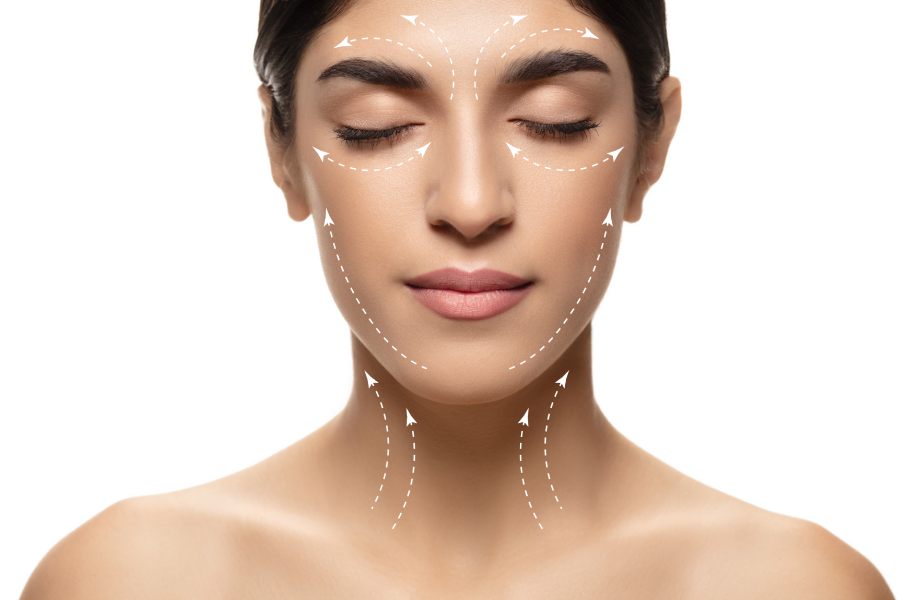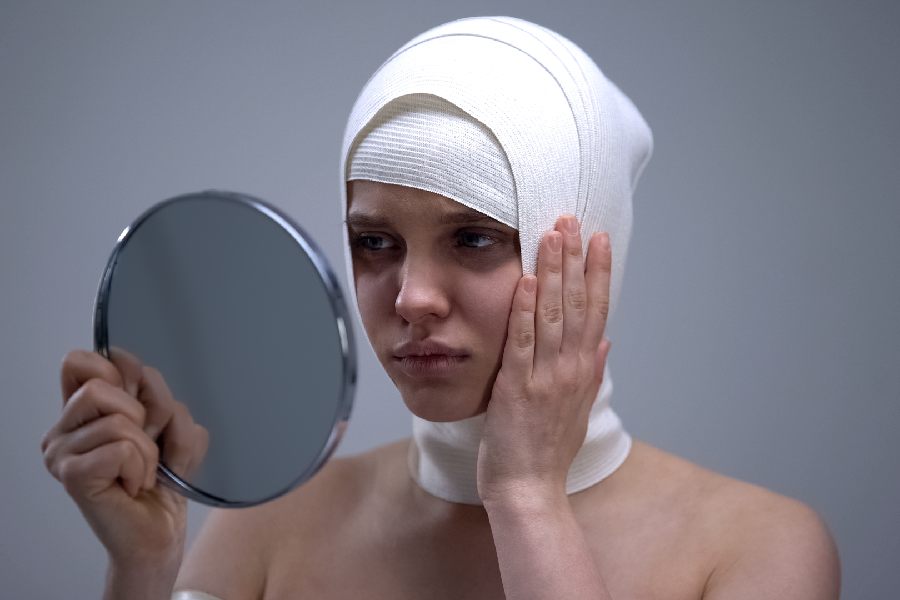After getting a facelift surgery, patients may experience swelling, bruising, and difficulty sleeping. The discomfort may last from a couple of weeks to a few months. If wondering when can I sleep on my side after facelift, keep reading to discover it.
Are you a side sleeper? There are some side sleeping restrictions post facelift operation. But that doesn’t mean you won’t be able to sleep on your side after some time passes. You just need patience and let your skin heal properly to get that rejuvenated look.
Follow-up appointments are crucial during facelift recovery. Your doctor can monitor your healing process and recommend sleeping positions after the surgery.
[ez-toc]

Source: shutterstock.com/ Photo Contributor: Master1305
When Can I Sleep on My Side After Facelift?
Patients consider the results of facelifts very appealing. But they don’t look forward to recovery after surgery because it interferes with their normal routines. You only need to get through the first weeks post-op and enjoy the long-lasting effects of facelift surgery.
So, when can I sleep on my side after facelift? Most patients take 2-4 weeks to feel comfortable resting on the side after facelift surgery. But the recovery time may vary from patient to patient because some people’s skin takes longer to heal.
Some patients have even reported that they could return to their normal activities sooner than expected. How quickly you may be able to resume side sleeping also depends on how extensive your facelift procedure is.
For example, some people choose to get a mini facelift. This type of procedure is performed quickly, and the recovery process is shorter. Thus, they might feel no pain and pressure when sleeping on the side after less than two weeks.
Before going back to your preferred sleeping position, ensure you are comfortable. You will know that sleeping on your side is safe only if you don’t feel like you are squishing your face on the pillow, which causes pain.
The Importance of Postoperative Sleeping Positions
The process of getting a facelift includes the doctor making incisions in your skin to tighten it and make it appear younger. The incisions are usually done near the forehead and sometimes behind the ears. Doctors advise avoiding pressure on the incision sites.
Thus, side sleeping during the first few weeks is not recommended because it may cause stress on your face. One of the most important parts of the recovery process involves paying attention to the recommended sleep positions following facelift.
The incision sites need time to properly heal until you can rest in your favorite sleeping position. But until then, you might need to make some temporary sacrifices when it comes to your sleep schedule, and to believe it will go back to normal soon.
Manage stress
Some patients experience more stress than pain after facelift surgery. This is due to the fear of being unable to return to normality which involves cooking, cleaning, and running errands. But all that can wait because your progress should be your main priority.
Don’t worry about wasting time lying down and doing nothing. Give yourself enough time to recover, and don’t forget to trust the process. If you are a person who wants to keep everything under control, run some errands and prepare some meals before you get the surgery.
Strive for comfort
Facelifts are more uncomfortable rather than painful. In the beginning, you may look at yourself in the mirror and think you look very bad. But it’s only going to get better.
Instead of focusing on your appearance during the initial stages of recovery, strive for comfort and create an environment where you can sleep peacefully.
Remind yourself that being comfortable is very important because it will allow you to get a good night’s sleep, promoting faster recovery.
Reduce swelling
Doctors can’t stress enough the importance of upright posture during facelift recovery. Keeping your head in this position when you are resting may reduce the painful swelling and speed up the healing process.

Source: shutterstock.com/ Photo Contributor: Motortion Films
General Guidelines for Sleeping After Facelift Surgery
Getting used to postoperative pain is never easy. But doctors recommend some general guidelines for sleeping after facelift surgery. These essential recovery practices might minimize swelling, ease the pain in your face, and prevent complications after the procedure.
Keep your head elevated
For the first weeks after a facelift, patients are advised to sleep with their heads elevated above their hearts to about a 30-degree angle. This practice may sound and look awkward at the beginning. But it’s actually very simple to accomplish.
You can either use a bed wedge or multiple pillows to elevate your mattress and position your head correctly. An alternative that doesn’t require effort is simply placing your travel pillow on your neck to keep your head elevated while sleeping.
Lie on your back
Plastic surgeons believe sleeping on your back is the best option to prevent your postoperative results from getting compromised by the appearance of wrinkles. It may also minimize swelling and prevent the stitches from pulling and tearing.
Most patients, both men and women, find this resting position more comfortable during the healing process after a facelift than side sleeping. It may prevent them from rolling over and moving too much during sleeping which is helpful if you want to avoid a healing delay.
Recommended time of sleeping on the back
Patients might expect to spend approximately two to three weeks sleeping on the back with their heads elevated. But this position’s duration doesn’t apply to every single patient since it differs based on multiple factors like the procedure’s type and extent.

Source: shutterstock.com / Photo Contributor: puhhha
Use cold compressions
Having swelling around your incision sites should come as no surprise. Every surgery, including facelifts, can cause swelling that may look discouraging for patients initially. But this is very common due to the skin being cut and tightened.
You might see swelling around the forehead, particularly around the eyes, cheeks, jawline, and neck, which is how bodies typically react to surgery. The swollen areas may feel sore for a few weeks, even when the swelling disappears.
Swelling is most noticeable after a facelift during the first three days. After that, it should start decreasing rapidly. But you can use cold compresses to help your face relax from the pain, discomfort, and discoloration caused by swelling.
For most patients, ice packs are the first thing that pops into their heads when they hear cold compressions. The cold may help reduce inflammation and promote swelling decrease. Use as many cold compressions as possible during the first three days after surgery.
Ensure you don’t put the ice directly on your skin to prevent burning. Place a towel or a cloth around the ice and keep it close to your face and neck. But avoid putting cold packs on your face after the initial three days pass. From now on, your skin has to heal naturally to get the best results.
Gradual Transition to Side Sleeping
Once you find a comfortable way to sleep, your body will be able to adjust and gradually transition to other sleeping positions naturally. You will be required to get used to sleeping on your back. So, transitioning to side sleeping shouldn’t be very challenging.
Your body can adjust to any sleeping position if it’s comfortable. When you feel like the swelling and pain has slowly gone away, you can try removing the extra pillows and bed wedge to position yourself on one side during sleeping.
But remember not to rush the process. Eventually, you will be able to sleep on your side again. What matters more is your comfort and peace during the night. Some patients are confident and comfortable sleeping on their side after one month of facelift surgery.
Tips for Comfortable Sleep During the Recovery Period
In addition to the common recovery practices like sleeping on your back and head elevation, there are additional things you can do to sleep comfortably. Prioritize resting and listening to your body during this vulnerable time.
Sleep in a recliner
You can purchase a special reclining chair for a good night’s sleep during the first few weeks of postoperative recovery. Some patients try everything they can to sleep in their beds. But it doesn’t always work, so they transition to a recliner.
The best feature of reclining chairs is that they prevent you from turning over and end up falling asleep on your side, and irritating the incision sites. Thus, they keep your body stable and straight.
Wear comfortable clothing
Wearing tight-fitting and itchy pajamas is one of the worst things you can do to your body while sleeping. You might already experience pain due to your facelift and don’t need additional discomfort. Thus, always ensure to wear comfortable clothing while sleeping.
Avoid drinking caffeine
According to a study, drinking caffeine may extend the recovery time after facelift surgery. It might also enhance postoperative pain and cause sleep loss. For this reason, doctors recommend avoiding caffeine during the healing process.
Don’t smoke cigarettes
Coffee and cigarettes go together even when they must be avoided. Nicotine may cause decreased blood flow, leading to skin tissue damage after the performance of many types of plastic surgery, including facelifts.
Stay away from alcohol
Usually, plastic surgeons advise their patients to refrain from consuming alcoholic beverages for at least two weeks after a facelift. Alcohol might increase swelling and the appearance of bruises and slow down healing.
Take your medication
Your doctor will likely prescribe pain medication after a facelift. Ensure you are prepared by purchasing them beforehand and always have them on hand at home. You can even keep them close to your bed in case of experiencing throbbing pain during the night.
Stay active and hydrated
Most doctors recommend patients avoid bending over, lifting heavy things, and excessive physical activity for one week after a facelift. But the good thing about facelift surgeries is that they don’t confine you to your bed, and you can take short walks even two days post-procedure.
Moving your body and drinking plenty of fluids may improve your blood circulation, overall mood and bedtime rest.

Source: shutterstock.com/ Photo Contributor: Pearl PhotoPix
Frequently Asked Questions
How can I speed up my facelift recovery?
Don’t expose the incisions to direct sunlight to help your skin recover faster after a facelift because this can cause damage. Also, ensure you always keep the incision sites dry and clean to prevent infections.
Can I ruin my facelift by sleeping on one side?
Are you asking when can I sleep on my side after facelift? Sleeping on your side immediately after may cause some complications. Due to the pressure on your face, your stitches might get distorted and negatively affect the final results. It may also cause swelling and prolong the recovery process.
How long does it take for a facelift to heal fully?
The pain and swelling after a facelift surgery might disappear after approximately six weeks. But you may have to wait longer to see the final results of the procedure. For some patients, the full healing process takes six months to a whole year.
